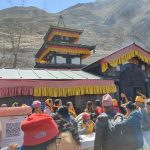Physical Address
304 North Cardinal St.
Dorchester Center, MA 02124

Makalu Barun National Park was established in 1992, is one of Nepal’s most spectacular and biologically diverse protected areas. Located in the eastern region of the country, the park is named after Mount Makalu, the world’s fifth-highest peak, towering at 8,485 meters (27,838 feet). Covering an area of 1,500 square kilometers, it extends from the tropical forests along the Arun River to the high Himalayan glaciers and snow-capped peaks. This remote and rugged park is the only protected area in the world with an elevation gain of more than 8,000 meters, from lowland forests to the summit of Mount Makalu. Known for its rich biodiversity, cultural heritage, and breathtaking landscapes, Makalu Barun National Park is a paradise for nature lovers, trekkers, and mountaineers.
Makalu Barun National Park is situated in the Solukhumbu and Sankhuwasabha districts of eastern Nepal. The park’s terrain is incredibly varied, with steep, forested valleys, lush green meadows, and towering snow-capped peaks. The area is drained by the Arun River, one of Nepal’s major river systems, which flows southward from the Tibetan Plateau.
The park experiences a wide range of climatic conditions due to its vast elevation differences. The lower valleys have a subtropical climate with warm temperatures and heavy monsoon rains, while the higher elevations experience a cold alpine climate.
Makalu Barun National Park is renowned for its incredible plant diversity, with over 3,000 species of flowering plants, including 25 species of rhododendrons, 47 types of orchids, and numerous medicinal plants. The park’s varied elevation and climate zones create distinct vegetation types, from tropical hardwood forests to alpine shrubs.
Makalu Barun National Park is a critical habitat for numerous endangered and threatened species. The park is home to over 80 species of mammals, 440 species of birds, 43 species of reptiles, and 16 species of amphibians.
The park is a birdwatcher’s paradise, with species such as:
Reptiles and amphibians thrive in the park’s diverse habitats, including several species of frogs, lizards, and snakes. The park’s pristine rivers and streams are also home to several species of fish, contributing to the overall biodiversity.
Makalu Barun National Park offers some of the most challenging and rewarding trekking and mountaineering opportunities in Nepal. The remote location and rugged terrain attract adventurers seeking solitude and pristine natural beauty.
The Makalu Base Camp Trek is the most popular trekking route in the park, offering trekkers a chance to experience the majestic beauty of Mount Makalu up close. The trek takes about 20 days, starting from Tumlingtar and passing through dense forests, high mountain passes, and remote Sherpa villages. The route offers spectacular views of not only Mount Makalu but also Everest, Lhotse, and other peaks.
For experienced mountaineers, Makalu is a challenging peak to climb. The mountain’s remote location, combined with technical climbing sections, makes it a formidable test even for seasoned climbers. The Makalu Expedition requires thorough preparation, technical skills, and acclimatization.
The region surrounding Makalu Barun National Park is rich in cultural diversity, home to various ethnic groups, including the Sherpa, Rai, and Shingsawa (Bhotia) communities. These communities have lived in harmony with nature for centuries, practicing sustainable agriculture and preserving their cultural traditions.
The Sherpas, renowned for their mountaineering skills, inhabit the higher regions of the park. Visitors can experience Sherpa culture by staying in local teahouses, visiting monasteries, and participating in traditional festivals.
In the lower valleys, the Rai and Shingsawa communities practice a blend of animism and Buddhism. Their traditional homes, farming practices, and rituals offer a glimpse into a way of life that has remained largely unchanged for generations.
Makalu Barun National Park is a critical area for biodiversity conservation in Nepal. The park is manage by the Department of National Parks and Wildlife Conservation (DNPWC) in collaboration with local communities. Conservation efforts focus on habitat protection, anti-poaching measures, and community involvement in sustainable tourism.
The park’s buffer zone, which surrounds the core area, is managed through a community-based approach. Local communities participate in conservation programs, reforestation efforts, and sustainable tourism initiatives, ensuring that the benefits of conservation are shared with the people who live in the region.
Efforts to protect endangered species, such as the snow leopard and red panda. These are supported by anti-poaching patrols and wildlife monitoring programs. The use of camera traps and satellite tracking has improved the understanding of wildlife movements and population trends.
Spring (March to May) and autumn (September to November): During these periods, the weather is stable, the skies are clear, offering excellent views of the mountains.
Spring is particularly beautiful, with rhododendrons and other flowers in full bloom, while autumn provides crisp air and stunning landscapes.
Makalu Barun National Park is accessible via a short flight from Kathmandu to Tumlingtar, followed by a drive to the trailhead at Chichila. From there, the trek to Makalu Base Camp begins. The remote location of the park means that trekking and mountaineering expeditions require careful planning and preparation. Local guides and porters are highly recommend to navigate the challenging terrain.
Makalu Barun National Park is a hidden treasure in the Himalayas, offering a unique combination of rugged wilderness, diverse ecosystems, and rich cultural heritage. Whether you are an avid trekker, a mountaineer, or a nature enthusiast, the park provides an unparalleled opportunity to explore one of Nepal’s most pristine and untouched regions. With its dramatic landscapes, rare wildlife, and warm hospitality. Makalu Barun National Park is a destination that promises adventure, serenity, and unforgettable memories.



